Getting water from nature to end users is a team effort involving those who pump and treat it; those in distribution who lay and maintain the pipes that send it out to homes, fire systems, and businesses; and those who interact with customers on service and billing issues. UWUA represents members who manage every step of this process.
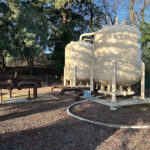 Depending on where you live, water may be pumped from underground aquifers or wells or be drawn from surface water like a lake or reservoir.
Depending on where you live, water may be pumped from underground aquifers or wells or be drawn from surface water like a lake or reservoir.
This first issue of our new series on “How It’s Done” spotlights five members who work in water treatment. They have a few things in common:
- All hold certifications and/or licenses from their respective states. States’ requirements vary but all involve passing rigorous tests, accruing time on the job, and fulfilling periodic renewal requirements.
- All must know and comply with their state’s specific regulations on drinking water quality and testing.
- All use a computer system called SCADA (Supervisory Control and Data Acquisition).
Each member profiled is part chemist, part mathematician, part computer scientist. All strive to maintain the highest quality standards in the water their team sends for delivery to customers.
Cody Sinnott
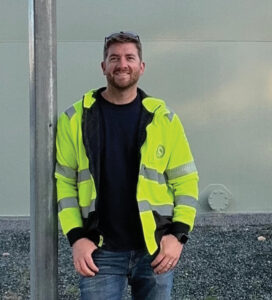 Local 160-D
Local 160-D
California Water Service (Cal Water)
Utility Relief Operator
Cal Water is the second largest water utility in the state, providing water to more than 2 million people. It’s divided into 23 geographic districts. Oroville, where I and five other Local 160-D members work, is one of the smallest, serving roughly 11,000 people through 3,300 service connections and providing up to 7.5 million gallons of treated water a day.
Most of our water comes from Lake Oroville, where two 5,000 gallon/minute booster pumps feed raw water into our storage reservoirs. Ensuring these pumps are providing adequate volume for customers and firefighting needs is one of my primary responsibilities, particularly given California’s fire concerns.
Once the water reaches the plant, gravity feeds it into our treatment process.
Oroville has 3 water treatment operators. One works day shift on weekdays; another operator and I work a rotating shift that allows us to alternate weekends and provide extra weekday coverage to check auxiliary wells, maintain booster pumps, and make any needed repairs. The plant runs 24/7, and there’s always someone on call to monitor the system through SCADA.
When water arrives at our facility, it’s injected with a coagulant to pull together bacteria, particles, and debris. Once mixed, it settles out through a series of baffles in progressive settling basins. In passing slowly through the settling basins, the coagulated particles have a chance to sink to the bottom. It’s then pushed through an intake screen.
We then treat with chlorine to kill any remaining microorganisms. We generate our own chlorine on site. It’s a mostly automated electrolysis process, but the operator must manually add salt and fine tune settings for optimal output. Chlorine is corrosive, so we spend a lot of time maintaining the chlorine room.
The chlorinated water flows into another holding basin, passing through multi-layered filters designed to trap anything else. It’s now almost ready to release, but Oroville has an ordinance requiring we add fluoride. The operator adds sodium fluoride to a saturator that injects the water before it is finished. We’re constantly testing fluoride levels to ensure they’re at safe levels. Protecting customer health and safety is our highest priority. We also monitor pH and chlorine multiple times a day. By the time the water leaves the treatment plant, we know that we’ve met or surpassed all state and federal guidelines.
A final boost of chlorine is injected before the water undergoes a mandatory holding period in a system of holding tanks where it must sit and let the chlorination take optimal effect. The operator calculates the holding time required based on pH levels and temperature. Treated water is then pumped into an above-ground storage tank that serves as the backbone of Oroville’s distribution system.
Mike Valenti
 Local 393, Suffolk County Water Authority
Local 393, Suffolk County Water Authority
Field Operator
Suffolk County is one of the largest groundwater authorities in the country, serving 1.2 million people. We have 250 pumping stations that draw water from five aquifers and multiple wells. I’ve been here 17 years, 16 of those in production control.
The work is organized out of 4 yards. I’m based out of Bayshore, where I pick up my truck in the morning and return it at the end of the day, refilling the truck’s chlorine tank so that it’s ready for the next shift.
Bayshore is also where our SCADA system is located. It’s a 24/7 operation run by control center operators, who are also members of Local 393. They monitor all 250 stations for volume, chemical levels, and security and flag any issues that arise.
I work on my own, and I’m responsible for 8 pumping stations. Others are doing the same job, and all 250 stations are checked each day. At every station, there’s a SCADA screen that alerts the operator of any issues that need to be addressed. I’ll do any repairs that I can; for those that require special trade expertise, I’ll prepare a work order for my supervisor.
Water comes into the station through a pipe, which has feeder tubes that inject lime to adjust pH and chlorine to kill bacteria. Part of my job is to make sure that the station has chlorine and lime. A supplier drops bags of lime at each station, and chlorine is stored in barrels that I refill as needed from the tank on my truck.
At each station, I record the time the well/pump has been running and volume produced. I’ll look at the analyzers that track pH and chlorine, do some testing to confirm these numbers, and collect samples to deliver to the system’s lab. Before I leave, I’ll adjust the chlorine if needed.
Once treated, the water is piped to a filter plant. The iron level in the water from some of the aquifers and wells is higher than others, so we filter it out. Water is also run through ultraviolet filters (which use ultraviolet light and peroxide) to kill any remaining bacteria. A final process removes the peroxide.
We have more stringent requirements than New York State and use our own central lab to test samples from all stages of the process. The state also conducts its own sampling.
Once we give the green light, the water is ready in terms of quality, but it also must be the right pressure. We pipe it to storage towers and tanks to keep the system pressurized before it flows to end users.
Tom Carchedi
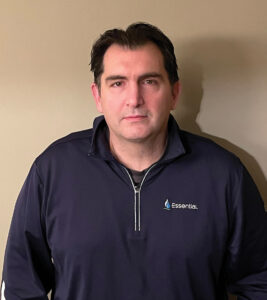 Local 425, Aqua Ohio
Local 425, Aqua Ohio
Lead Operator
Local 425 members operate the Struthers Plant that serves Eastern Ohio. Different UWUA locals represent workers at the company’s eight other plants. The plant is staffed 24/7. You’ll always find one plant operator on site, while another might be conducting testing and doing pump maintenance. I spent 7 years as a plant operator before becoming a lead operator last May.
Struthers gets its water from a nearby lake, where a dam and intake system screen out large items like branches and fish before a low lift pump sends the water to the plant. On an average day, we’ll send 5 to 6 million gallons out to customers. The treatment process takes about 4 hours from the time water arrives until we release it.
We use filters and several chemicals for treatment. The operator calculates chemical doses based on water volume. Coagulants are added to build floc (i.e. large clusters) and lime and soda ash for softening. When the larger particles settle to the bottom of the tank, the clear water is sent through filters to capture smaller impurities. We then add chlorine to kill any remaining pathogens, and the water is sent to one of our clear wells. Throughout, the operator is testing and verifying that state quality regulations are met.
Once chlorine reaches the desired level, the operator releases the water into the distribution system, controlling the volume for expected usage. It travels through main water lines to storage tanks in the areas we serve. From these tanks, it proceeds to customers’ homes.
We monitor usage based on pressure in the system and water levels in the tanks. Through the information we see on SCADA, we often are the first to see problems, such as a drop in pressure due to a main break, and we’ll alert distribution.
Beyond treatment duties, operators maintain chemical feed equipment, conduct preventive maintenance on calibration machines, monitor and backwash filters, oversee chemical deliveries, and coordinate with the mechanic to maintain pumps. The lead or relief operator conducts monthly customer site visits for testing, ensuring compliance with state environmental standards.
Heather Novak
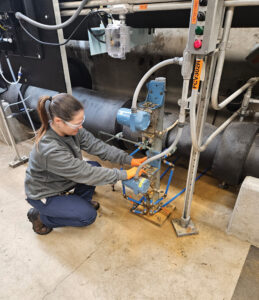 Local 648, Pennsylvania American Water
Local 648, Pennsylvania American Water
Maintenance Technician
My company provides 1.6 billion gallons of water each month to 137,000 customers and 7,300 fire hydrants in the Wilkes-Barre/Scranton area. The system has 33 reservoirs and a few wells, but they’re not all active at once. We operate 9 treatment plants with capacities ranging from 1 to 22 million gallons/day.
On a typical day shift, you’ll find one plant operator and two maintenance technicians at each plant. I spent 15 years as a plant operator before recently switching over to maintenance technician. Sometimes, you may see a few non-union personnel at the plant, such as IT support, telemetering, an electrician, or a pump specialist.
Part of the operator’s job is to monitor the volume flowing from the reservoirs into the plant. It’s automated, with SCADA adjusting based on demand.
When the water arrives, we add a coagulant to help filters trap dirt and large particles. Once it’s pushed through the filters, we add chlorine to disinfect, lime or caustic to balance the pH, and a corrosion inhibitor to prevent the release of metals once the water is in distribution pipes. It’s a fast process. Each plant handles different volumes, but on average, water leaves the plant within an hour of arriving.
The plant operator’s job involves a lot of data collection, tracking, and analysis in SCADA. We monitor SCADA for red flags and anything else that might require attention.
While there’s a fair amount of automation, the job is also physically demanding, involving loading non-bulk chemicals, such as 50 lb. bags of lime, into the hoppers, mixing chemicals that require dilution with water before injection, and ensuring that chemicals are batched properly. The plant operator is also continuously testing. We test raw water, we test after chemicals are added, and we test again before it leaves the plant. Quality is paramount.
Day shift operators have a slightly different job than those on night shift, doing more lab work and tracking deliveries. On night shifts, you’ll find an operator at the larger plants but not the smaller. Night operators tend to their own plant and, together with SCADA, remotely monitor unstaffed plants. If something goes wrong, an on-call operator and/or maintenance tech will be sent to investigate.
Plant operators also work with maintenance technicians to monitor algae levels in the reservoirs. It’s a team effort between maintenance techs doing visual assessments and plant operators conducting chemical testing.
Adam Soulliere
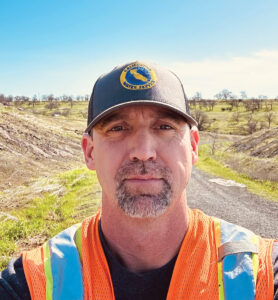 Local 160-D, California Water Service (Cal Water)
Local 160-D, California Water Service (Cal Water)
Foreman of Production Department
Chico is one of Cal Water’s largest, and oldest, districts, dating back to 1926. We get our water from a network of 65 wells. As Foreman of Production, I oversee the water pumping and treatment process. I’m responsible for ensuring each active well is visited once a day by one of my local’s 6 pump operators.
Every well site has a motor and pump, with varying output capacities ranging from 500 to 1,500 gallons/minute. We store chlorine in drums at each site, and a chlorine injection mechanism doses small amounts into the water as it comes out of the ground. If a well has run since last visited, we’ll check how much chlorine it used. The operator adjusts the chlorine levels according to the volume being pumped and tests to ensure that chlorine levels meet state standards. We do most of our work during the day shift and rely on SCADA to monitor the network during the off-hours.
Wells go on and off-line depending on system demand. In February, we had 51 wells in active use and produced about 10 million gallons/day. That volume triples in summer months.
Sometimes a well is taken off-line because testing shows it’s been impacted by some sort of environmental pollution. Water at sites like these requires more than just chlorine to bring it to safe drinkability levels. We’ll remediate using activated carbon to pull contaminants out of the water.
Water testing is a big part of the operator’s job. California has a stringent testing regimen, ranging from weekly bacteriological sampling to testing for certain metals every 11 years. Should any parameter exceed safe thresholds, we take immediate action.
After treatment, the water is piped to one of six above-ground storage tanks located throughout the district. When the water arrives, it flows through a mixing pipe that churns the incoming water with that already in the tank. We test the chlorine at this point to ensure we’re maintaining required levels; if they’ve dropped, we’ll cycle in more water in to bring levels back up. When volume is released from the tanks into the distribution network, it is now at sufficient pressure to meet the needs of our district’s 115,000 customers and 4,500 fire hydrants.

